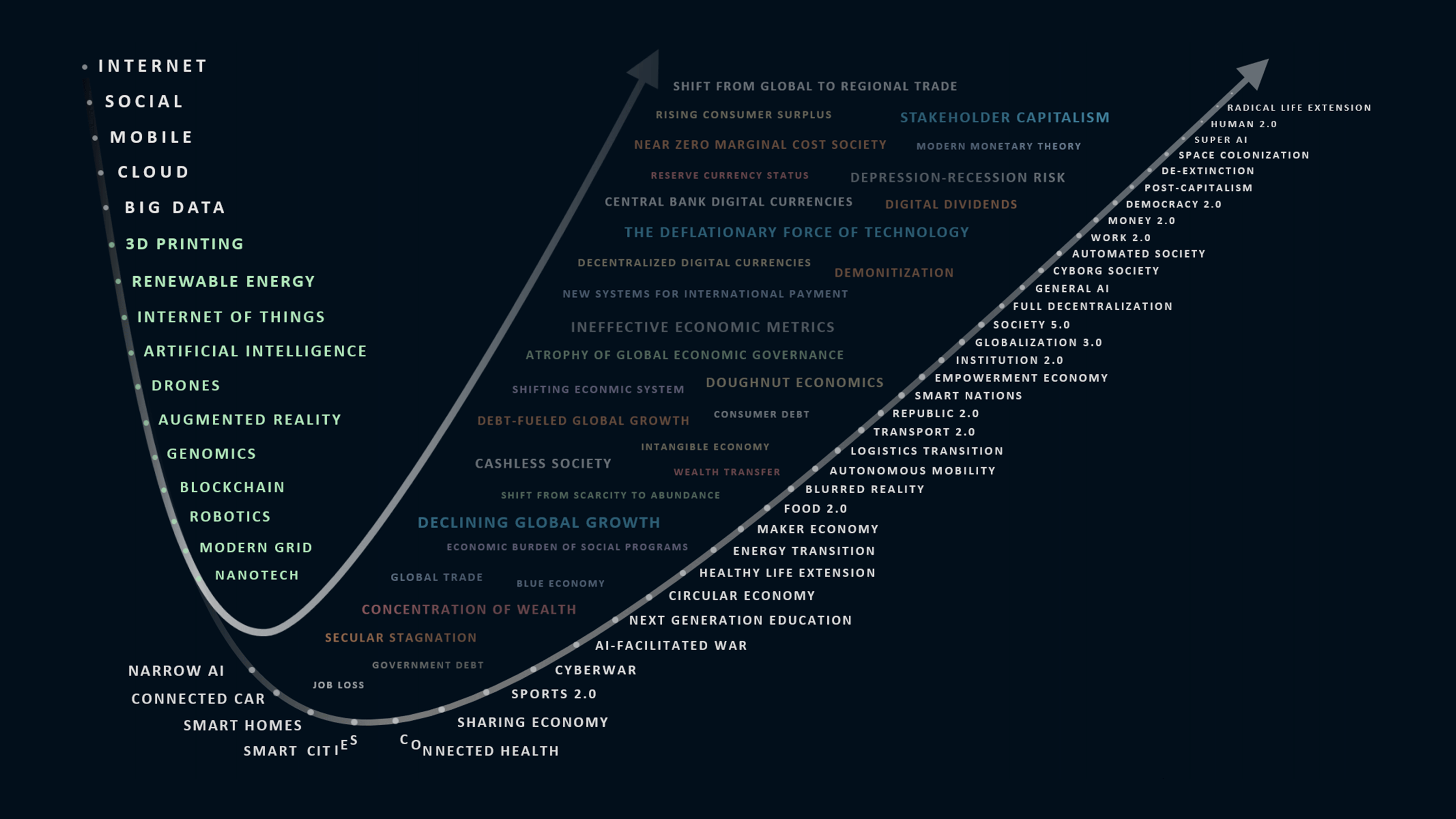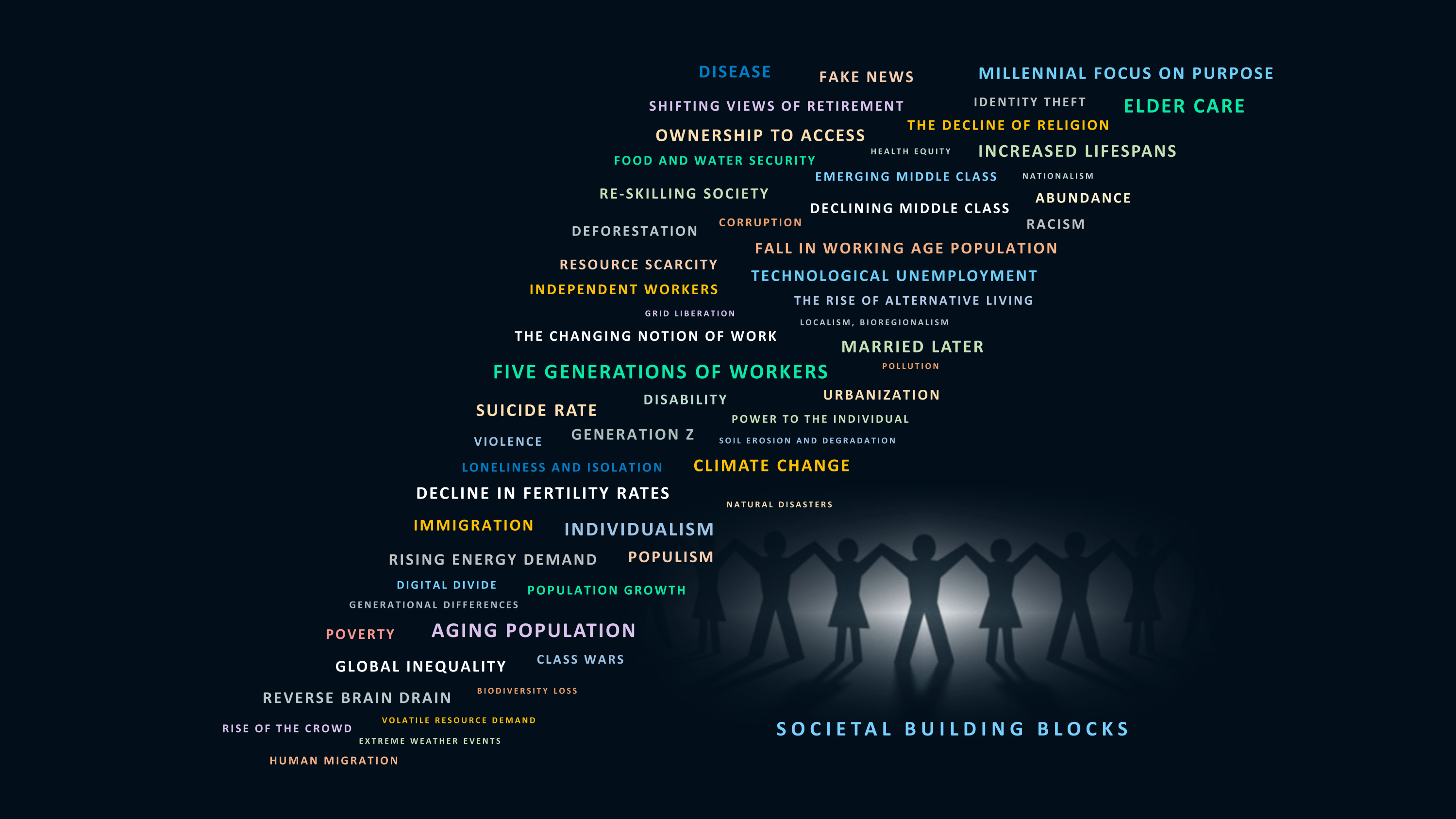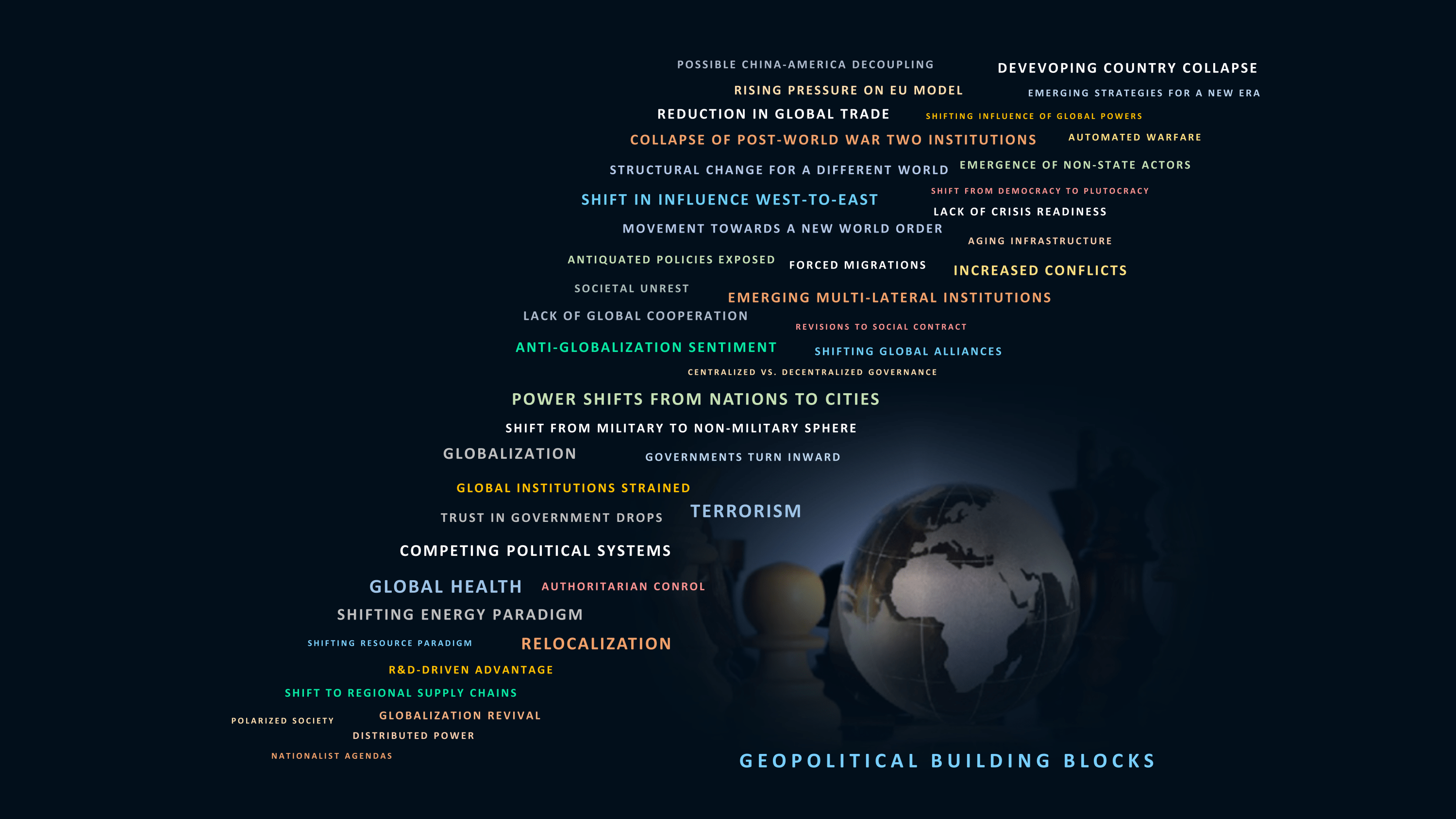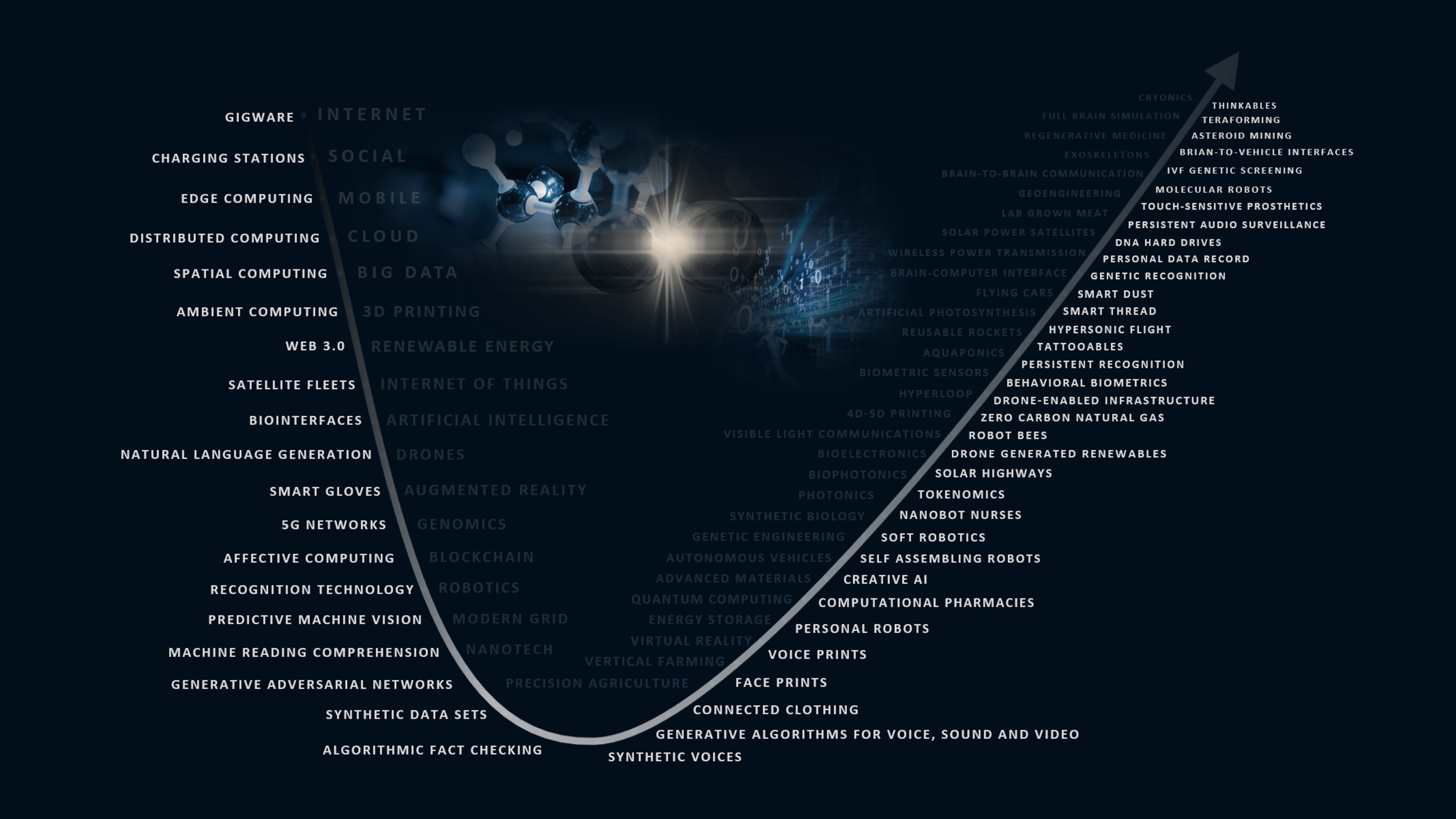My previous posts launched a series that will tell the full story of a reimagined future. Described as a journey through the looking glass, the story began with a series description and a look back in time. The series continues, with each post featuring a piece of our journey. We explored the extreme uncertainty of the future in the last post. In this post, I will now dive deeper into the building blocks of the future.
THE BUILDING BLOCKS OF THE FUTURE
I believe a growing number of building blocks across multiple domains makes prediction impossible and the future more ambiguous than prior periods. That ambiguity makes many uncomfortable. Humans like certainty, but we live in a world that is very uncertain. Many will argue that this has always been the case. But it should be increasingly clear that periods like this emerging phase transition have only occurred a handful of times in human history. We want to rely on methods that have proven effective in the past. We find comfort in applying those methods to drive a degree of certainty. One need only look at the overwhelming number of building blocks to see that the best we can do is identify possible futures. Therefore, understanding the future is about rehearsing it versus predicting it.
Building blocks across science and technology get a lot of attention for obvious reasons. Every day we learn of new innovations that serve both as accelerants and possible game changers. For example, we recently learned that a new machine-learning model could enable robots to understand interactions the way humans do. Yet, as powerful as science and technology are, a number of societal building blocks play a significant role in shaping possible futures. Examples of these building blocks appear every day. For example, a recent article focused on the decline in fertility rates and the significant impact that this one building block is likely to have on the future. There are others as well, like an aging population, global inequality, and a drop in working age population (click the visual to open in a new window for a broader list).
Beyond societal building blocks are a growing number in the geopolitical and economic domains. This story is best told by exploring the differences between a phase transition and previous transformative periods. The fact that so many building blocks exist across every domain is at the very least a warning sign. Current and future economic forces converge with others in ways that shape a given path. Stories of truck drivers that are not surprised that the industry is struggling to hire and retain workers provide signals: supply chains will be impacted and automation will accelerate. That creates a ripple effect back towards societal forces that converge in other unpredictable ways. The geopolitical domain promises to be extremely volatile, as stories like AI shaping the future of war begin to dominate the headlines. The emergence of a second global power to challenge the existing power is a major building block. History has a lot to say about how this scenario has played out in the past. These two visuals capture several geopolitical and economic building blocks (click to enlarge).
Taken together, is it any wonder that leaders are overwhelmed? It’s not just the pace of change, extreme events, or challenges to existing mental models. It is this sheer number of building blocks both existing and emerging. Factor in convergence occurring across these building blocks, and you have a recipe for uncertainty, unpredictability, and an overwhelming number of possibilities. It was the book titled The Second Machine Age written by Andrew McAfee and Erik Brynjolfsson, where the point was underscored. As the authors described, it is the combinatorial nature of the environment that amplifies complexity and likely transforms our world. All this says that we must see the future at some level, rehearse it, and adapt to its inevitable shifts. See-rehearse-adapt becomes the framework.
I use this visual to identify several building blocks associated with science and technology. Every time you look up, the list grows. An example of that phenomenon is reflected in yet another article that identifies emerging advances. The article via Adrien Book identifies ten technologies that he believes most have probably never heard of. The ten are:
| LiFi | YOLOv5 | Robotic bees | Seawater fuel | 20-minute Water |
| 4D-printing | Energy-storing Bricks | Zero-knowledge proof | Femtosecond Projection Two-Photon Lithography | Unnamed Dynamic Neural Networks technology |
The science and technology curve captures this overwhelming story. For those new to the visual, it attempts to identify several factors that converge synergistically across the science and technology domains. The curve portrays the exponential progression of both science and technology and the reciprocal influence that one is having on the other. This progression continues its unabated exponential rise, and leaders can only see so far on the curve. This creates an uncertainty that makes it difficult to understand its implications into the future. Some of these accelerators are in our line of sight and their impacts already felt. Others are emerging with an expected impact, and still others are far off in the distance with no ability to gauge impact.
When you consider that the visual represents science and technology building blocks, not the building blocks that span geopolitics, society, economics, environment, and philosophy – or the future scenarios they spawn – how could the rapid convergence across them all not transform the world? That first curve spawns a second very broad curve. It identifies future scenarios that span areas including health, materials, food, transport, logistics, energy, shelter, agriculture, governing, war, security, manufacturing, and the future of the human species. It is this second curve that creates the need for new organizing systems. We have never witnessed the sheer number of shifts occurring at the same time, and if that isn’t enough, building blocks across the domains referenced earlier amplify impact. There is an interesting reciprocal tension at work here, as these other domains are impacted or squeezed by the curves, while at the same time, creating a reciprocal effect.

This list of emerging and future accelerators is by no means an exhaustive list, but it captures the magnitude and speed of impact. As convergence on the science and technology curve accelerates, it will spawn additional future scenarios – and the cycle continues. As it does so, society will follow two paths – a constructive path that enhances society, and a destructive path that diminishes it. How we manage those paths determines the future that we will talk about when looking back from 2050. This is the topic of the next post in the series.
First Post in the series: A Journey through the Looking Glass
Second Post in the series: The Journey: An Historical Perspective
Third Post in the series: The Journey: A Growth Of Knowledge
Fourth Post in the series: The Journey: Our Current World Order
Fifth Post in the series: The Journey: Convergence Drives Human Advancement
Sixth Post in the series: The Journey: Catalysts Of The Past And Those On The Horizon
Seventh Post in the series: The Journey: A Phase Transition
Eight Post in the series: The Journey: Our Complex, Uncertain, And Volatile Future





[…] Ninth Post: The Building Blocks Of The Future […]
LikeLike
[…] exponential progression of science and technology is driving a staggering pace of innovation. The building blocks are mostly there, allowing creative minds to combine them in ways that deliver new forms of value. […]
LikeLike
[…] Ninth Post: The Building Blocks Of The Future […]
LikeLike
[…] Ninth Post: The Building Blocks Of The Future […]
LikeLike
[…] Ninth Post: The Building Blocks Of The Future […]
LikeLike
[…] Ninth Post: The Building Blocks Of The Future […]
LikeLike
[…] world is experiencing another period of great invention. We have the building blocks of the future, but to drive human advancement, the resulting innovation needs to scale. […]
LikeLike
[…] wave of invention builds upon the last, with subsequent waves accelerating on the strength of new building blocks that emerge and the growth of knowledge. We stand on the shoulders of brilliant people that came […]
LikeLike
[…] 1990s, it is easy to see a great demographic reversal ahead – and it is simply a handful of building blocks in a growing sea of […]
LikeLike
[…] of building blocks that allows us to rapidly innovate – a phenomenon I describe in detail here. The maturation of foundational technologies combined with this combinatorial phenomenon is an […]
LikeLike
[…] many who have revolutionized industries and spearheaded technological advancements, early experiences with blocks often spark a lifelong path of inquiry and creativity. By fiddling […]
LikeLike